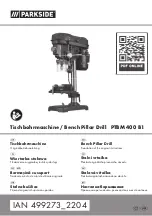
ELECTRICAL INFORMATION
WARNING
: The warnings, cautions, and instructions discussed in this instruction manual
cannot cover all possible conditions and situations that may occur. It must be understood
by the operator that common sense and caution are factors which cannot be built into this
product, but must be supplied by the operator.
Note: Performance of this tool may vary depending on variations in local line voltage.
Extension cord usage may also affect tool performance.
VOLTAGE WARNING
Before connecting the tool to a power source (receptacle, outlet, ect.) be sure the voltage
supplied is the same as that specified on the nameplate of the tool. If one says 120V and
the other says 115V then there will be no complications. Never try to plug a 120V tool into
a 240V outlet, or the other way around. A voltage greater than that specified on the tool
can result in
SERIOUS INJURY
to the user, as well as damage to the tool. If in doubt,
DO
NOT PLUG IN THE TOOL
.
DOUBLE INSULATION
Double insulated tools are equipped with a polarized two-prong plug (one blade is wider
than the other). This plug will fit in a polarized outlet only one way. If the plug does not fit
fully into the outlet, reverse the plug. If it still does not fit, contact a qualified electrician to
install a polarized outlet. Do not alter or change the plug in any way. Double insulation
eliminates the need for three wire grounded power supply and grounded power cords.
EXTENSION CORDS
Improper use of extension cords may cause inefficient operation of your tool which can
result in overheating. Be sure your extension cord is rated to allow sufficient current flow
to the motor. If you are using the tool outdoors, use an extension cord rated for outdoor
use (signified by “WA” on the jacket).
The extension cord must have a minimum wire size depending on the amperage of the
tool and the length of the extension cord. This size is determined by its AWG (American
Wire Gauge) rating. The smaller the gauge, the greater the cable’s capacity. The amount
of cords used does not matter: Total length determines the minimum AWG rating. Every
cord must meet the AWG rating. Use the chart below to determine what AWG rating is
required for your situation. Cord length is rated in feet.
LENGTH OF
CONDUCTOR
0-25 FEET
26-50 FEET
51-100 FEET
WIRE SIZE REQUIRED
(AMERICAN WIRE GAUGE)
120V LINES
NO.14
NO.14
NO.12


























